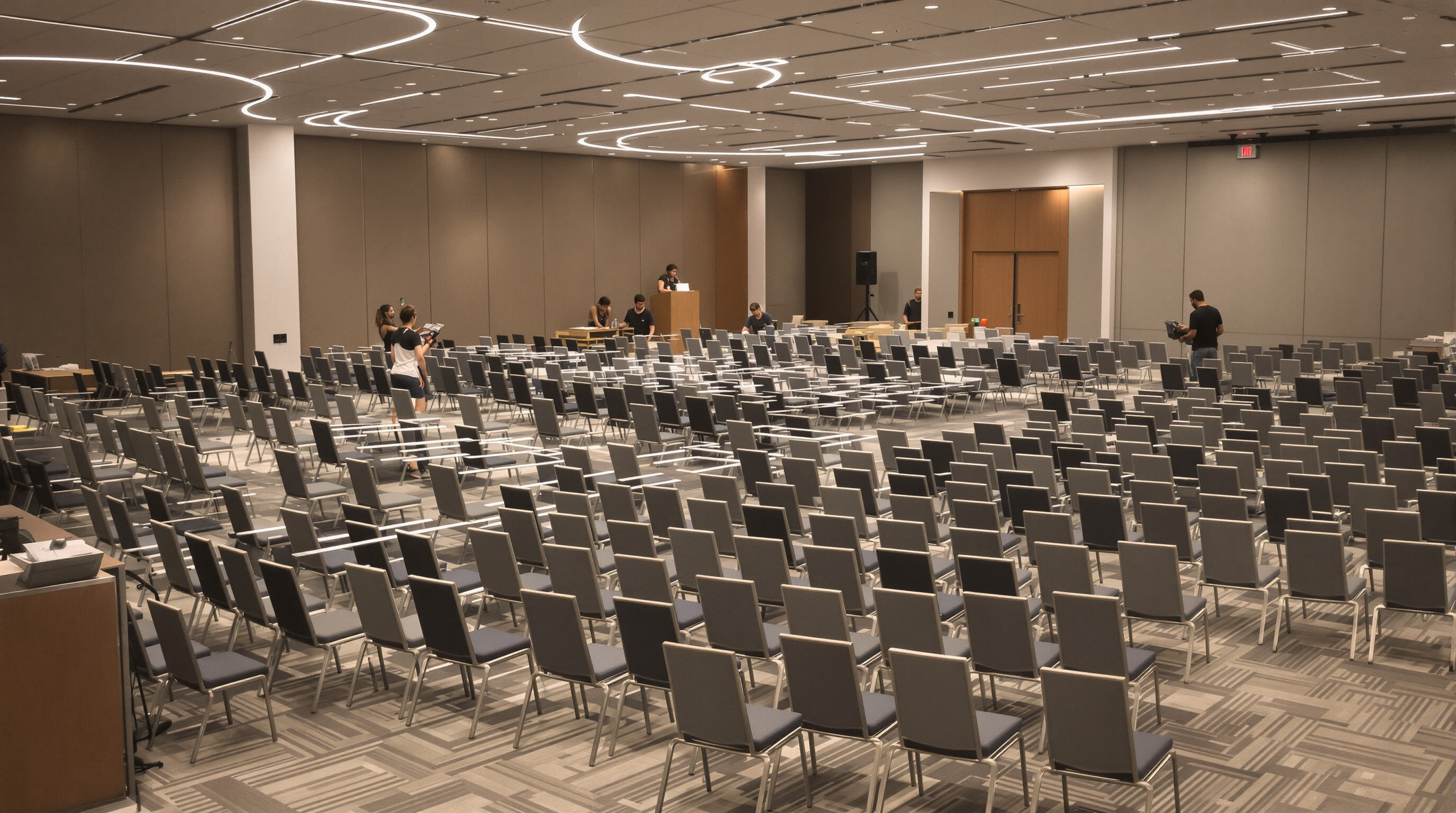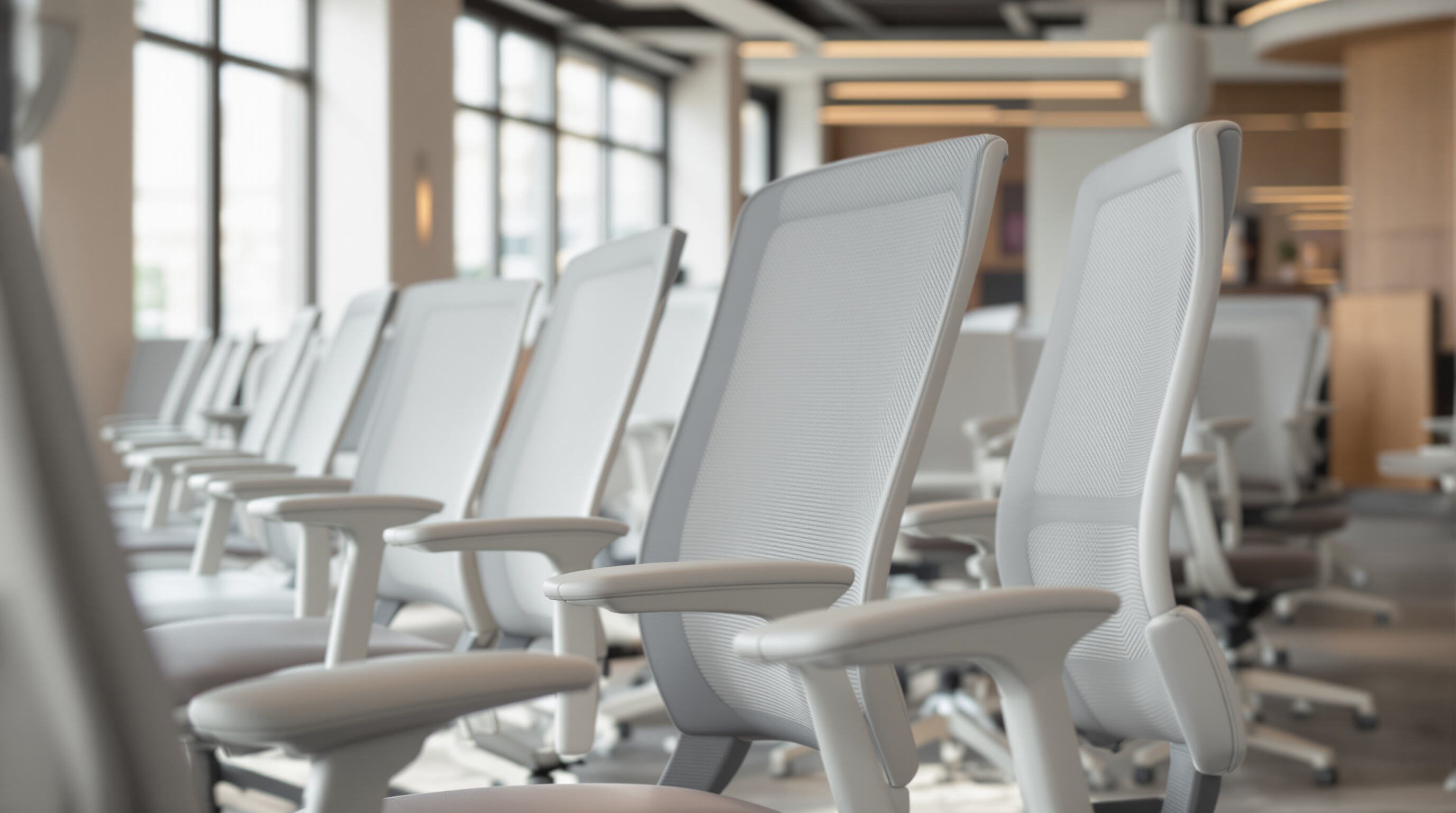Assessing Room and Meeting Requirements for Optimal Conference Chair Selection
Understanding Meeting Types: Internal Employee Sessions vs. Client-Facing Presentations
When it comes to picking out conference chairs, the first step is figuring out what kind of meetings will be happening there. For regular team updates, comfort matters most. People need good back support when they're sitting through long brainstorming sessions, plus those swivel bases really help keep conversations flowing between different groups. But things change when clients are involved. The look of the chairs suddenly becomes super important too. Leather seats and sleek designs send a message about how serious a company takes its image. According to some studies floating around, almost seven out of ten professionals actually connect chair quality with whether they trust a business enough to do deals with them face to face.
Evaluating Meeting Frequency, Duration, and Seating Utilization Patterns
High-traffic boardrooms require conference chairs with commercial-grade frames (minimum 300 lb capacity) and scratch-resistant finishes. For spaces hosting back-to-back sessions, prioritize seats with quick-adjust levers and breathable fabrics. Analyze weekly usage reports to identify wear patterns—facilities with 20+ hourly meetings monthly often benefit from reinforced armrests and replaceable casters.
Determining Room Size and Attendee Capacity for Efficient Space Planning
Use industry-standard spatial guidelines:
- Minimum Clearance: 32" behind chairs for circulation
- Per-Person Width: 24"-30" for seated comfort
- Sightline Optimization: Chairs under 34" seat height for unobstructed screen views
A 400 sq. ft. rectangular room optimally accommodates 12 conference chairs in a U-shaped layout, while circular configurations reduce capacity by 15% but enhance participant engagement.
Aligning Chair Layout with Room Acoustics, Sightlines, and Technology Integration
Conference chairs should be placed at around 15 degree angles from sound systems to cut down on echoing problems. When setting up for hybrid events, make sure chair backs aren't blocking cameras either. Low profile chairs under about 42 inches tall tend to work better in rooms with lots of technology. Before finalizing arrangements, run some tests through CAD software to check if most seats (around 9 out of 10) can see the big screen clearly. The display needs to be at least 85 inches across and positioned so people sitting 15 feet away still have good visibility without straining their necks.
Scalability and Flexibility: Adapting Conference Chairs to Dynamic Meeting Demands

Modular Conference Chair Systems for Seamless Scalability in Large Rooms
Modular conference chair setups solve the problem of dealing with groups that keep changing size while still keeping everything functional. What makes these systems work so well? They come with parts that can be swapped around seat clusters, those clever linking pieces between chairs, and special docking stations for accessories. With all this flexibility, event planners can go from hosting just 20 executives for a quick meeting to setting up space for 200 people at a product launch within half an hour flat. The standardized connectors make sure everything stays lined up properly when rearranging, which matters a lot for both sightlines and sound quality in the room. According to recent data from 2024 on how venues get used, nearly seven out of ten operators put this kind of alignment right at the top of their priority list.
Mobility Features: Casters, Swivel Bases, and Quick-Reconfiguration Designs
Mobility parts that perform at high levels really boost how adaptable spaces can be. Take commercial grade casters with those weight activated brakes for instance. They let people move things around easily but still keep everything stable when in use, something that matters a lot for places hosting event after event throughout the day. The swivel bases that rotate all 360 degrees help folks work together better, and there are also legs that adjust without needing tools to deal with floors that aren't completely flat. Venues across the country have noticed significant time savings too. One convention center reported cutting their setup time by almost half once they switched to chairs featuring built in pull handles along with those slide and lock caster systems.
Case Study: Scalable Seating in Multinational Corporate Boardrooms
One major bank recently hit an impressive 92% space usage rate after rolling out tiered modular seating solutions at their 37 offices around the world. The setup works pretty well actually – they've got these radial clusters for smaller client meetings (usually between 8 to 12 people), then there's the traditional theater style arrangement when hundreds need to gather for big company announcements, and finally some flexible pods equipped with all the necessary audio visual gear for those mixed in person/remote sessions. Looking at what happened after installation, the numbers tell quite a story: meetings started happening in the same rooms much more often (up by 33%) and storing extra furniture became significantly cheaper too (down 19%). This just goes to show why investing in adaptable office layouts makes sense for companies trying to keep pace with changing business demands without constantly tearing things apart and starting over.
Ergonomic Design for Sustained Comfort During Extended Large-Scale Meetings

Key Ergonomic Features: Lumbar Support, Adjustable Armrests, and Seat Depth
Conference chairs for extended use require three core ergonomic elements:
- Lumbar support that adapts to spinal curves, reducing lower back strain during 3+ hour meetings
- Adjustable armrests (height, width, and pivot) aligned with table heights and user proportions
- Seat depth customization (18"–22" range) to prevent leg circulation issues, paired with 1"-thick foam for optimal pressure distribution
Proper implementation of these features reduces attendee repositioning by 47% in meetings exceeding 90 minutes, according to a 2024 workplace efficiency study.
Supporting Focus and Productivity Through Long-Meeting Comfort
Ergonomic conference chairs directly impact cognitive performance. Optimal seat tilt (4°–6° backward angle) and breathable mesh backrests reduce thermal discomfort by 34% (Occupational Health Journal, 2023). Height-adjustable models (17"–21" range) ensure proper thigh support across diverse body types, maintaining blood flow critical for sustained attention in strategy sessions.
Balancing Aesthetics and Ergonomics in Executive Spaces
Conference spaces that see constant use require seating solutions where comfort meets professional aesthetics. Think about chairs with leather wrapped around the lower back area that actually complements those expensive boardroom tables. The bases are made from slim aluminum profiles that hide all sorts of cables underneath, so nothing looks messy. And the swivel mechanism? It operates quietly below 45 decibels, which means people can move around without creating annoying background noise. These days manufacturers are hiding all the adjustable parts inside sleek frames, making sure they meet international ergonomic standards but still look good enough when clients walk into a meeting room expecting something stylish yet functional.
How to Choose a Conference Chair That Meets Large-Scale Meeting Needs?
Durability, Materials, and Long-Term Value in High-Use Conference Environments
When selecting conference chairs for high-traffic environments, material durability directly impacts long-term cost efficiency and user satisfaction.
Comparing Upholstery Materials: Fabric, Leather, and Performance Composites
Fabric chairs let air circulate and tend to be budget friendly, but they need regular cleaning. Most fabric upholstery gets replaced after just three years when placed in busy areas according to industry data showing around 65% replacement rate. Leather looks upscale and doesn't collect dust as easily, yet it wears down quicker from constant use unless treated properly with conditioners regularly. For businesses looking at long term solutions, performance materials have taken over lately. These include stuff like antimicrobial polyester mixes that stand up better to wear and tear. The 2023 Material Innovation Report notes these composites last about 70% longer against abrasion compared to traditional options. Plus they work well with those harsh cleaning chemicals found in hospitals and schools where sanitation standards are strict.
Frame Strength and Weight Capacity for Heavy Daily Use
For conference chairs meant for serious business use, look for frames made from steel or reinforced aluminum that can handle over 15 thousand daily seatings without breaking down. Chairs rated for more than 300 pounds of weight capacity won't suffer from structural issues over time. The leg joints on these professional models have been put through rigorous testing, which cuts down on wobbling problems by around 82 percent when compared to cheaper alternatives according to research published in Ergonomic Design Journal last year. Another smart design element is modular construction where parts can be taken apart and replaced individually. This makes fixing damaged components much easier and means these chairs often stay in service for well over eight years before needing replacement.
Data Insight: 73% of Facility Managers Prioritize Longevity Over Upfront Cost
A 2023 Facility Management Report revealed that 73% of professionals prioritize chairs with 10+ year lifespans despite higher initial costs. This aligns with data showing durable models reduce replacement cycles by 40% over five years, offsetting upfront investments through lower lifetime ownership costs.
Specialized Conference Chair Solutions for Diverse Business Applications
Tailoring Seating: Training Rooms, Boardrooms, and Hybrid Meeting Spaces
Conference chairs today need to fit different situations pretty well. Training areas work best with light weight chairs that can be stacked quickly when rearranging the space becomes necessary. Executive boardrooms tend to look more professional with those high back leather seats everyone associates with important meetings. Then there are hybrid spaces where people switch between in person and virtual meetings all day long. These spots need chairs equipped with camera mounts and materials that cut down on background noise so video calls don't get disrupted. According to recent research from last year, about two thirds of companies have started looking at modular seating options that can handle multiple functions across various meeting environments.
Smart Conference Chairs With Integrated Power and Connectivity Options
Modern workspace designs are starting to feature things like USB-C ports alongside wireless charging stations so devices stay powered up all day long. There's also better cable management solutions built right into the AV systems throughout entire rooms, plus those adjustable tablet mounts that let multiple people see what's on screen at once. The result? Offices look much tidier than they used to. Some studies suggest these changes cut down on visual clutter by around 40 percent give or take. And this matters because more companies are letting employees bring their own gadgets to work these days, especially in tech industries where personal devices have become pretty much standard equipment.
Inclusive Design: Accessibility Considerations for Diverse User Needs
ADA-compliant conference chairs address three critical needs: seat heights adjustable from 17" to 19" for wheelchair transfers, armrests with 5" clearance for mobility aid compatibility, and textured upholstery with contrasting colors for low-vision users. Manufacturers are adopting universal design principles, ensuring 95% of users can operate chair mechanisms without assistance—a 30% improvement since 2020.
FAQ Section
What are the key ergonomic features to look for in conference chairs?
Key ergonomic features include lumbar support that adapts to spinal curves, adjustable armrests, and seat depth customization to prevent leg circulation issues.
How do modular conference chair systems benefit large meeting spaces?
Modular systems allow for quick reconfiguration of seating arrangements, accommodating changes in group size and maintaining alignment for optimal sightlines and sound quality.
What materials are best for durable conference chairs?
Performance composites like antimicrobial polyester mixes are preferred for their durability and resistance to wear and tear, especially in high-traffic areas.
How can conference chairs be adapted for diverse user needs?
ADA-compliant chairs offer adjustable seat heights, armrest clearance for mobility aids, and textured upholstery for low-vision users, enhancing accessibility.
Table of Contents
-
Assessing Room and Meeting Requirements for Optimal Conference Chair Selection
- Understanding Meeting Types: Internal Employee Sessions vs. Client-Facing Presentations
- Evaluating Meeting Frequency, Duration, and Seating Utilization Patterns
- Determining Room Size and Attendee Capacity for Efficient Space Planning
- Aligning Chair Layout with Room Acoustics, Sightlines, and Technology Integration
- Scalability and Flexibility: Adapting Conference Chairs to Dynamic Meeting Demands
- Ergonomic Design for Sustained Comfort During Extended Large-Scale Meetings
- How to Choose a Conference Chair That Meets Large-Scale Meeting Needs?
- Specialized Conference Chair Solutions for Diverse Business Applications
- FAQ Section

